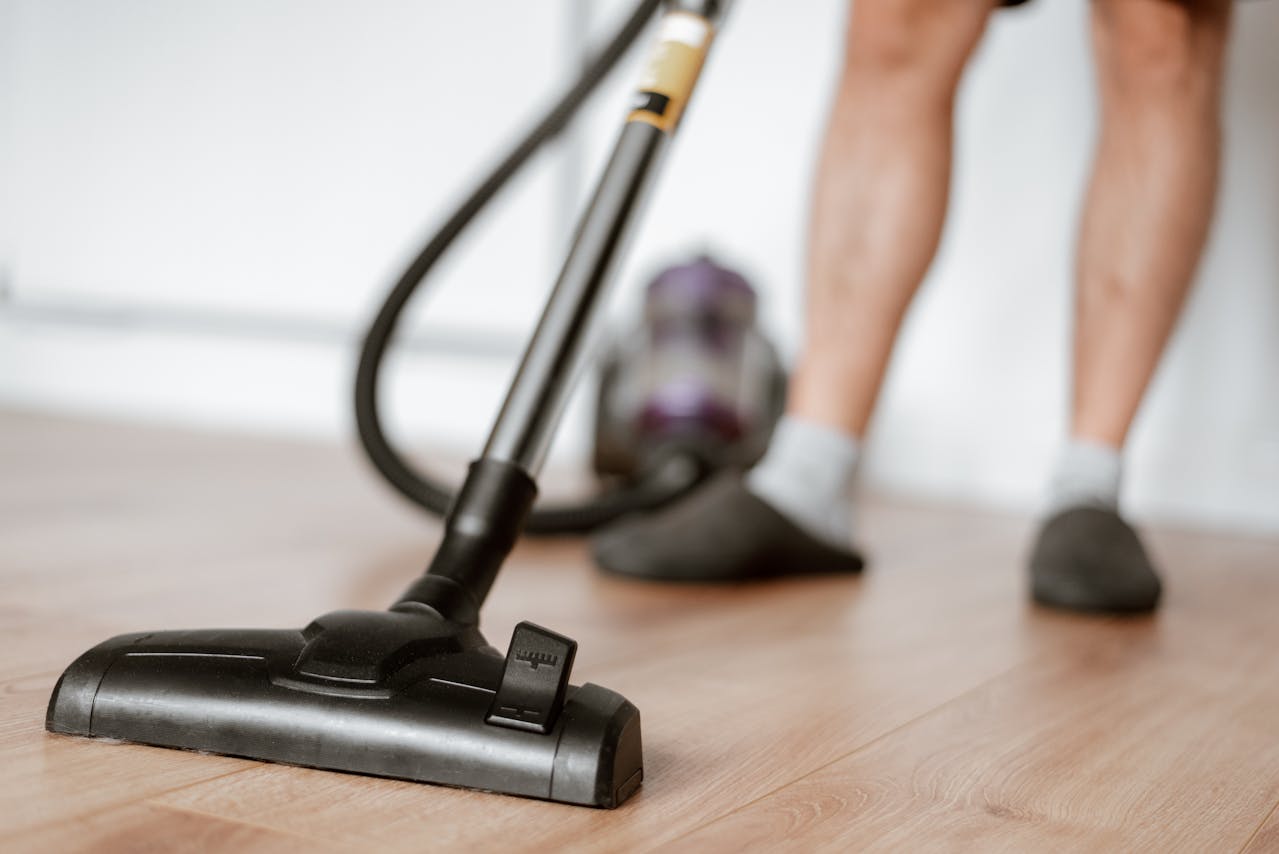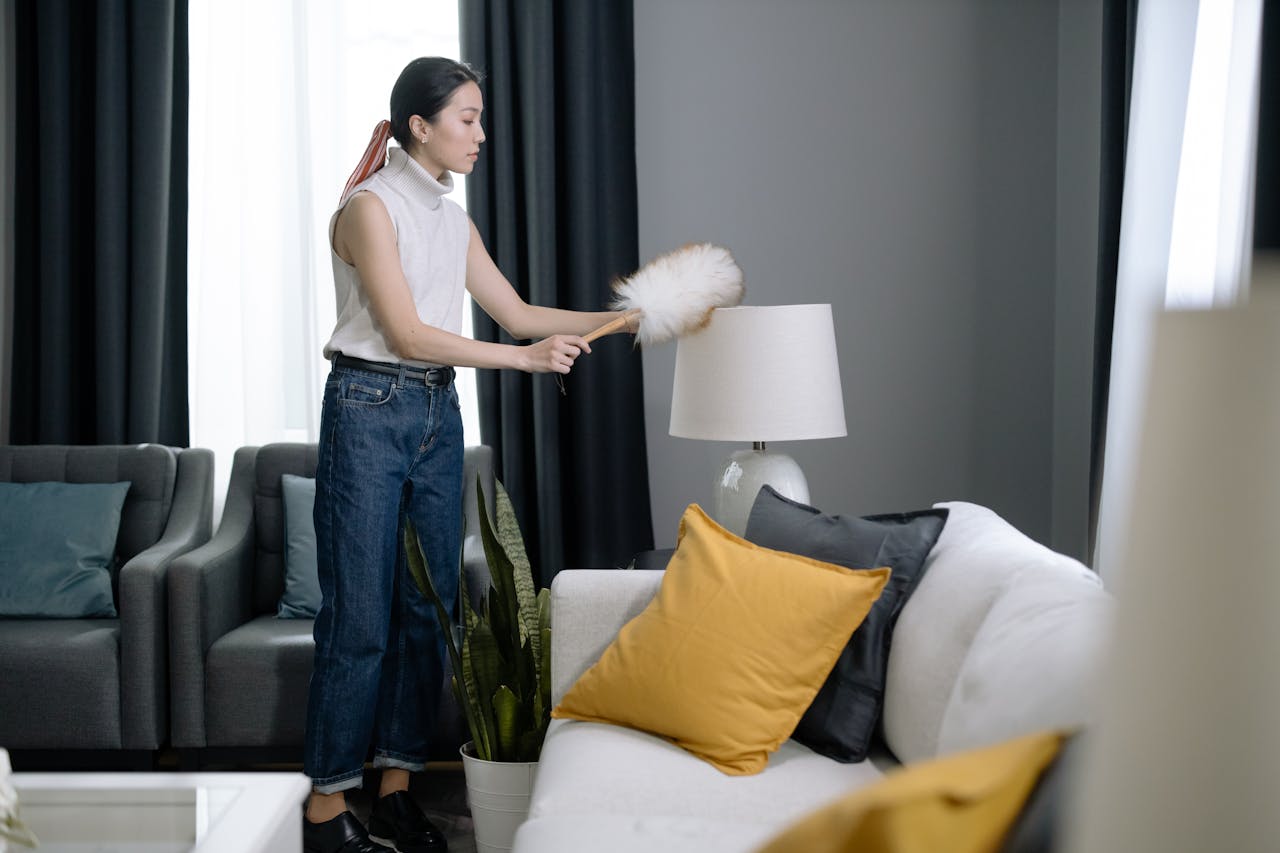Quentin Crisp once (in)famously stated that dust doesn’t get any worse after seven years if you have the strength to leave it alone or words to that effect. While a few lazy so-and-sos have used this statement to justify their sloppy housekeeping, most agree that dusting is integral to domestic cleaning work. And, Quentin, it does so get worse – I’ve had to clean out the den my late grandmother left untouched for over seven years before her death.
Why dust at all? Is dusting just an aesthetic thing designed to ensure all your surfaces and ornaments are seen at their best (and window sills are safe from folk who try writing their name or the words “Clean me” in the dust)? While this is an essential part of dusting – after all, can you appreciate the beauty of a lovely finish or the delicate details of a sculpture if it’s covered in an ugly patina of grey – there’s more to dusting than that.
The importance of dusting is seen when you consider what dust is. Most people can probably guess that dust is made of bits of fluff that get rubbed off clothing and carpets, mixed with windblown dirt from outdoors. However, dust also contains skin flakes that you, your visitors, and your pets shed. As everyone who’s ever watched a cop show on TV, one of the basic premises of forensics is that everywhere we go, we leave minute traces of ourselves. Every time you make the slightest move, you shed a small avalanche of microscopic skin particles. (As an aside, if you ever have the misfortune of having to call the police in because your home has become a crime scene, resist all impulses to tidy up, even though your instincts say that the house should be orderly when important people come to call. Do not straighten a cushion; don’t vacuum.)

And microscopic animals live on these skin flakes: dust mites. While these little beasts are insignificant, they can have a devastating effect. The droppings of dust mites are one of the most powerful allergy triggers we know, and it is widely thought that these droppings are responsible for triggering asthmatic attacks. If you dust (and vacuum) your house regularly, you remove the food source of these mites and thus reduce the likelihood that a family member or a guest will have an asthmatic attack.
So, how do you dust? The blatantly obvious answer is “with a duster, of course.” The whole aim of dusting is to collect the dust so it can be removed from where you don’t want it and get it into a place where it can be washed away or dumped into the compost heap. Dusters that flick the dust up into the air do no good at all – the dust will merely resettle.
The best duster is a soft cloth, preferably slightly damp (it should not be dripping). A soft cloth will not scratch delicate surfaces while dusting and will hold enough water to stick the dust to itself. You can use paper towels for dusting, but these are more expensive and can’t be reused; they also tend to disintegrate after a few minutes of dusting. If you are doing a heavy-duty dusting session, you will need several dusters, as the one you start will turn black very long before.
The best thing about dusting is that everybody agrees it is one household chore that doesn’t require chemicals. If you hear anyone saying that dusting does, ignore them. And you don’t have to bother buying fancy clothes to use as a special duster. Old sheets, towels, T-shirts, and tea towels make excellent dusters, which is a good way of recycling these once they have worn too thin and are not used as intended.
What Is Dust?
Dust is a term related to tiny particles suspended in the atmosphere. It comes from a wide variety of sources. For example, everyday household dust comes from skin particles and fabrics, while industrial dust comes from wood and metal materials. The fine particles are not visible to the human eye, but when concentrated, they may create a haze in the atmosphere. The tiny flakes shed from our bodies and fabrics settle around your house. In some places, the dust stays still, while in other areas where frequent movements happen, it rises in the air and settles in another place. Fighting the dust is almost impossible, but following these simple steps may help you reduce the amount of dust at home and save you efforts.
Change bedding
We spend significant amounts of time in bed, and bedding collects many skin flakes. To reduce the dust in the bedroom, you need to change pillowcases and sheets every week. Duvets and blankets could be washed less frequently, but you can at least shake them outside to remove some of the accumulated dust. Even clean linen sheds fibres, but this is normal.
Capture dust
When cleaning your house, use a damp cloth rather than a feather duster or a dry cloth to remove dust. Use your vacuum cleaner’s attachments to clean difficult-to-reach areas where dust usually gathers.
Shake area rugs
Carpets and rugs absorb a considerable amount of dust and must be vacuumed regularly to reduce the dust and dust mites stuck in their fibres. Some people who suffer from dust allergies have found a solution, and instead of carpets, they install hard floors in their homes. Rugs are a great addition to a hard floor, but they need to be beaten to give them a more thorough cleaning, as beating removes more dust than vacuuming. Consider investing in a small rug-beater machine – your house cleaning will never be the same with that little piece of equipment in your cleaning cupboard.
Beat upholstery cushions
Upholstery also absorbs dust, and we raise fine particles stuck into the fibres every time we sit down. As with carpets and rugs, upholstery must be vacuumed at least once weekly. In addition, cushions should be taken outside and beaten to remove the dust. An alternative to fabric upholstery is leather, which doesn’t absorb dust and can be cleaned easily with a damp cloth.
Clean the air
Open windows regularly, especially while cleaning. Although dust from outside will enter your home, fresh air improves indoor air quality.
Use light fabric curtains.
Do not use blinds on your windows. Instead, use curtains made of light fabric that can be washed easily. Wash them every couple of months or whenever you feel it is time.
Keep floors clear
You need to find a place for all items on the floor to make them more accessible when vacuuming. If the floor is cluttered, there is a higher chance of missing certain areas when cleaning.

Anyclean’s Professional Tips For Dust Control
- Install an electrostatic precipitator in your furnace’s air duct. The charging section of the electrostatic precipitator positively charges the particles. At the same time, the receiving end has a negative charge that restrains the particles, bringing your house a little closer to dust-free.
- A vacuum with a high-efficiency particulate arresting (HEPA) filter is the most efficient means of filtering air. There are also a couple of new brands of vacuum on the market which use high-powered air to suck the dust right out of the carpet and swirl it around until the actual particles dissolve, to put it in oversimplified terms. These vacuums are expensive but are cutting-edge technology for homes with a high probability of dust-causing allergies.
- Large, “room-size” air filters should be placed in bedrooms and other rooms where family members sleep or spend much time. They filter harmful particles and allergens out of the air you breathe, making them more than worth their usual moderate price. As technology progresses, these are becoming smaller and more efficient.
- Electrostatic air filters, like the electrostatic precipitator, provide reliable air filtration and ease of cleaning or maintenance. They can be removed from the filter quickly, cleaned, and used again! These are much like the ones you see on TV: remove the collection grid, wipe it with a clean rag, and then replace it. The collection grids hardly ever have to be replaced when damaged, so this air filtration system is the longest-lasting for the money. The downside is that they only cover a small area with maximum air cleaning quality, so you may need one for each room of the house if dust allergies are terrible.
- Use a humidity gauge and subsequent air conditioning as appropriate to ensure that the humidity level in your home is no higher than fifty per cent. In the winter, the humidity level should be between thirty-five and fifty per cent. Dust mites thrive in warm, humid environments. Dry them out!

